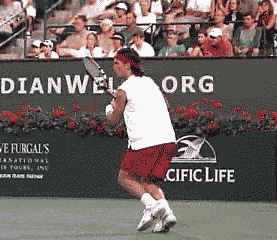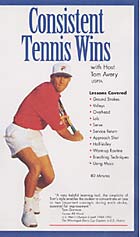|
TennisOne QuickTips
How to Hit with Topspin and Control Tom Avery
Everybody's talking about topspin because it allows the pros to hit the ball with tremendous force, yet clear the net by a safe margin and still pull the ball back down into the court. You don't have to be a nuclear physicist to figure out what imparts topspin to a tennis ball. A clear understanding is all you need. Basically it is a ball that spins forward after the strings strike it. So, what's so great about a ball spinning forward? Once a ball starts to spin forward, it creates air pressure on top of the ball pushing it down. This is the main reason everyone likes topspin. They don't have to be a Las Vegas type player who hits net skimmers, always flirting with danger. They can safely get the ball four to six feet over the net, with power and the ball is still pulled back down before sailing long. To make a tennis ball spin forward, the racquet must be moving from low to high at contact. The racquet should drop at least one foot below the contact point before swinging forward to meet the ball. This ensures a low to high swing. It's this low to high motion that will cause a brushing up at contact that makes the ball spin forward. The racquet must be in a vertical position (straight up and down) when contact is made. If the racquet is tilted or laid back at contact you do not get this brushing effect. The strings should make contact at the equator of the ball, that imaginary line around the center of the ball. If you try to come up and over the top and hit above the equator, you will simply drive the ball into the net. This over the top theory is actually a common myth that will really hurt your ability to hit topspin consistently in the court. Two Key Points To Concentrate On During Your Swing
Fig. 1(above) - The racquet face is closed, the palm is down, the racquet is now set to be vertical at contact. Fig. 2 - The racquet is vertical at contact, striking the “equator” of the ball because the swing was from the shoulder without wrist and forearm rolling. Fig. 3 - This is a key photo, notice that the ball is gone and the racquet is still continuing on a low-to-high plane, remaining vertical. There has been no rolling over. But topspin has been imparted. Fig. 4 - The racquet continues on the low-to-high plane, finishing high, the shoulder has been used as the hinge throughout the swing. Your comments are welcome. Let us know what you think about Tom Avery's article by emailing us here at TennisOne.
Tom Avery is the author of the series, Consistent Tennis Wins. Learn why unforced errors occur in your game and how to train your body to play more consistent tennis in Consistent Tennis Wins with Tom Avery. In this 80 minute production, Avery covers groundstrokes, volleys, overheads, lobs, serves, approach shots, half-volleys, the correct warm-up, breathing techniques and more.
Price: $44.99 DVD $39.99 VHS |



